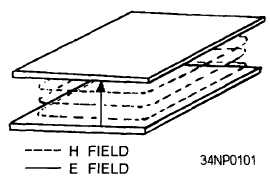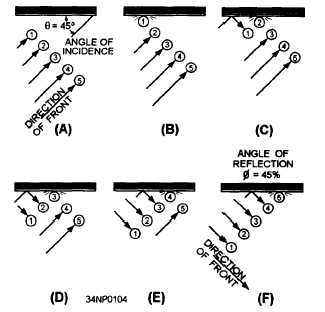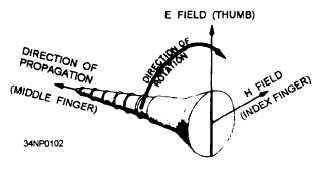Figure 3-28.—H field boundary condition.
Since an E field causes a current flow that in turn
produces an H field, both fields always exist at the
same time in a waveguide. If a system satisfies one
of these boundary conditions, it must also satisfy the
other since neither field can exist alone.
WAVEFRONTS WITHIN A
WAVEGUIDE
Electromagnetic energy transmitted into space
consists of electric and magnetic fields that are at right
angles (90 degrees) to each other and at right angles
to the direction of propagation. A simple analogy to
establish this relationship is by use of the right-hand
rule for electromagnetic energy, based on the
POYNTING VECTOR. It indicates that a screw
(right-hand thread) with its axis perpendicular to the
electric and magnetic fields will advance in the
direction of propagation if the E field is rotated to
the right (toward the H field). This rule is illustrated
in figure 3-29.
Figure 3-29.—The Poynting vector.
The combined electric and magnetic fields form
a wavefront that can be represented by alternate
negative and positive peaks at half-wavelength
intervals, as illustrated in figure 3-30. Angle
is
the direction of travel of the wave with respect to some
reference axis.
Figure 3-30.—Wavefronts in space.
The reflection of a single wavefront off the “b”
wall of a waveguide is shown in figure 3-31. The
wavefront is shown in view A as small particles, In
views B and C particle 1 strikes the wall and is
bounced back from the wall without losing velocity.
If the wall is perfectly flat, the angle at which it the
wall, known as the angle of incidence
is the same
as the angle of reflection
An instant after particle
1 strikes the wall, particle 2 strikes the wall, as shown
Figure 3-31.—Reflection of a single wavefront.
3-14








